Running Out of Drive Letters?
50+ years in computers
EE FELLOW 2017 — first ever recipient of Fellow award
MVE 2015,2016,2018
CERTIFIED GOLD EXPERT
DISTINGUISHED EXPERT
EE FELLOW 2017 — first ever recipient of Fellow award
MVE 2015,2016,2018
CERTIFIED GOLD EXPERT
DISTINGUISHED EXPERT
Published:
Browse All Articles > Running Out of Drive Letters?
Bellevue, WA, USA; Late December, 1980
"OK, folks, we nailed the IBM contract. We're going to have many meetings like this to discuss features and functions...and how to move from 86-DOS, the CP/M clone we just purchased, to our baby, MS-DOS. This meeting is to discuss drive letters."
"Well, even the first IBM PC is going to offer an option for two floppy drives, so we'll need A and B."
"Yeah, but at the NCC in May, Shugart showed a 5.25-inch hard drive that's going to work in a PC!"
"Wow! I missed that...a hard drive in a PC?! You gotta be kidding. What's the capacity of that bad boy?"
"I've never seen one, but the announcement said five megabytes! And that's after formatting!"
"Yikes! Who is ever going to need 5 MB on a PC?! How would you ever fill it up?!"
"Who knows, but I think we should plan for it...they're already shipping 'em, although IBM hasn't announced it as an option in the PC...yet. We know there will always be two floppy drives, A and B, so let's plan on the hard drive being C."
"I'm skeptical about needing such huge storage capacity in a PC, but OK...C it is."
"Look, guys, call me crazy, but as long as we're doing A, B and C, let's give them the whole alphabet! That way, we're protected forever into the future. No one could ever possibly need more than 26 drive letters!"
"No way! That's insane! I want to implement this as efficiently as possible, and with three drive letters, we can do that in two bits...and even keep 00 as a flag. We'll code A as 01, B as 10, and C as 11. In the absurd possibility of a fourth drive, we could use 00 as drive D, although we'd have to do some reprogramming if we used 00 as a flag."
"No need for restricting it to two bits and being careful about memory utilization...I hear that the first PC will have a whopping 64 KB on the motherboard!"
"Yeah, but that's going to be way too expensive for most folks. I suspect the typical purchase will be for the model with 16 KB and no floppy drives...and certainly no hard drive, which Shugart says will cost $1,500!"
"You guys are all wet! I think people are going to buy the model with the maximum memory of 256 KB and with two – count 'em, two – floppy drives. And if there really is a way to get that Shugart hard drive in a PC, people will go for it. Look, we can fit 26 drive letters in five bits and have room left over for a half-dozen flags if we need 'em. Using five bits is well worth it to future-proof our OS!"
"I thought we'd get this decided today, but I can see it's a difficult issue that needs further study. I don't know...26 drive letters...sounds wacky to me...but let's give it some thought and meet again tomorrow."
Fast forward more than three decades – 26 drive letters do not cut it! With ubiquitous terabyte hard drives containing four partitions and with network shares, including NAS devices, all over the place, it is not unusual to run out of drive letters. This article focuses on hard drives in a Windows PC, both internal and external (connected via USB, firewire, eSATA, whatever) and discusses one simple technique to free up drive letters (there are surely other methods, which perhaps some members will post in the comments). The article does not discuss the issue of network shares, which was addressed in a recent EE question entitled, Best practice assigning drive letters/mapping drives.
"OK, folks, we nailed the IBM contract. We're going to have many meetings like this to discuss features and functions...and how to move from 86-DOS, the CP/M clone we just purchased, to our baby, MS-DOS. This meeting is to discuss drive letters."
"Well, even the first IBM PC is going to offer an option for two floppy drives, so we'll need A and B."
"Yeah, but at the NCC in May, Shugart showed a 5.25-inch hard drive that's going to work in a PC!"
"Wow! I missed that...a hard drive in a PC?! You gotta be kidding. What's the capacity of that bad boy?"
"I've never seen one, but the announcement said five megabytes! And that's after formatting!"
"Yikes! Who is ever going to need 5 MB on a PC?! How would you ever fill it up?!"
"Who knows, but I think we should plan for it...they're already shipping 'em, although IBM hasn't announced it as an option in the PC...yet. We know there will always be two floppy drives, A and B, so let's plan on the hard drive being C."
"I'm skeptical about needing such huge storage capacity in a PC, but OK...C it is."
"Look, guys, call me crazy, but as long as we're doing A, B and C, let's give them the whole alphabet! That way, we're protected forever into the future. No one could ever possibly need more than 26 drive letters!"
"No way! That's insane! I want to implement this as efficiently as possible, and with three drive letters, we can do that in two bits...and even keep 00 as a flag. We'll code A as 01, B as 10, and C as 11. In the absurd possibility of a fourth drive, we could use 00 as drive D, although we'd have to do some reprogramming if we used 00 as a flag."
"No need for restricting it to two bits and being careful about memory utilization...I hear that the first PC will have a whopping 64 KB on the motherboard!"
"Yeah, but that's going to be way too expensive for most folks. I suspect the typical purchase will be for the model with 16 KB and no floppy drives...and certainly no hard drive, which Shugart says will cost $1,500!"
"You guys are all wet! I think people are going to buy the model with the maximum memory of 256 KB and with two – count 'em, two – floppy drives. And if there really is a way to get that Shugart hard drive in a PC, people will go for it. Look, we can fit 26 drive letters in five bits and have room left over for a half-dozen flags if we need 'em. Using five bits is well worth it to future-proof our OS!"
"I thought we'd get this decided today, but I can see it's a difficult issue that needs further study. I don't know...26 drive letters...sounds wacky to me...but let's give it some thought and meet again tomorrow."
The default Windows behavior is to assign a drive letter for every formatted partition on a hard drive. But in many cases, you don't need the drive letters, as the devices are for backups, clones, disk images, or simply not accessed often. In these cases, it is possible (and easy!) to remove the drive letter assignments, so that these drive letters are available for other purposes, such as hard drive partitions and network shares that are accessed frequently, where having a drive letter is very convenient.
Removal of a drive letter may be accomplished in Disk Management, which is accessed as follows:
Control Panel
Administrative Tools
Computer Management
Disk Management
If you access Disk Management just occasionally, the four steps above are fine. But if you use it more often, I suggest putting a shortcut to it on your Start Menu, Taskbar, and/or Desktop (wherever you prefer). The shortcut should be to:
%SystemRoot%\system32\disk
When running Disk Management, I recommend setting the top view to Volume List (via the menu View>Top) and the bottom view to Graphical View (via the menu View>Bottom). When you do that, you'll see something like this:
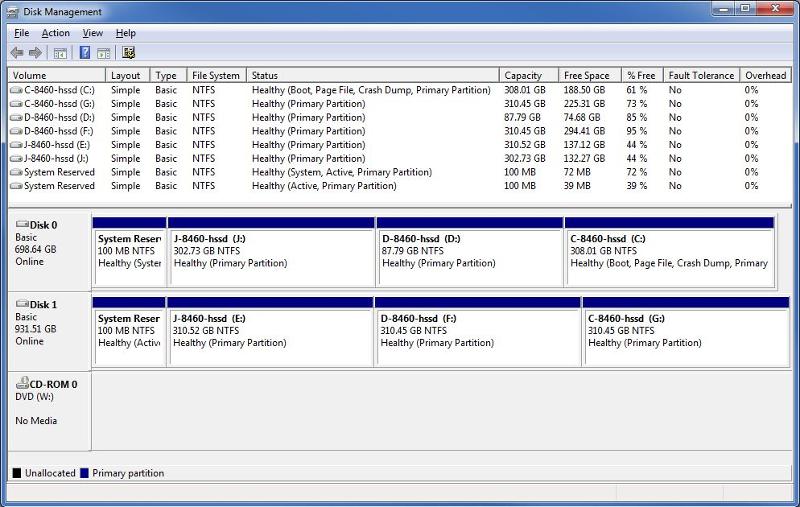
In this case, my Disk 1 is a clone of Disk 0 and I really don't need the drive letters (E, F, G) for its partitions, as the cloning software doesn't need them and I rarely look at its folders/files with my file manager. So, to remove a drive letter that has been assigned, right-click on it (in either the top view or bottom view) to get this context menu:
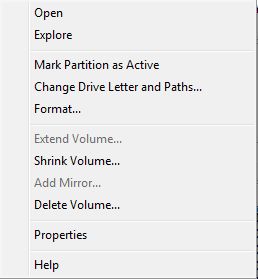
Then select Change Drive Letter and Paths..., which produces a dialog like this:

To remove the drive letter assignment, click the Remove button. You will get this warning:
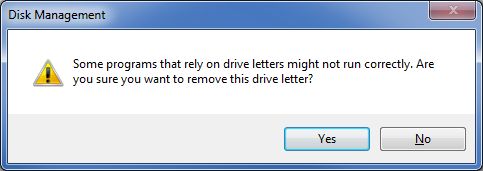
Click the Yes button and the drive letter is gone! That letter is available now for any other usage. Of course, the procedure is easily reversed. So, if you want to reassign the drive letter, right-click on the partition, which still appears in the top and bottom views but without the drive letter, as shown in this screenshot after removal of the E drive:
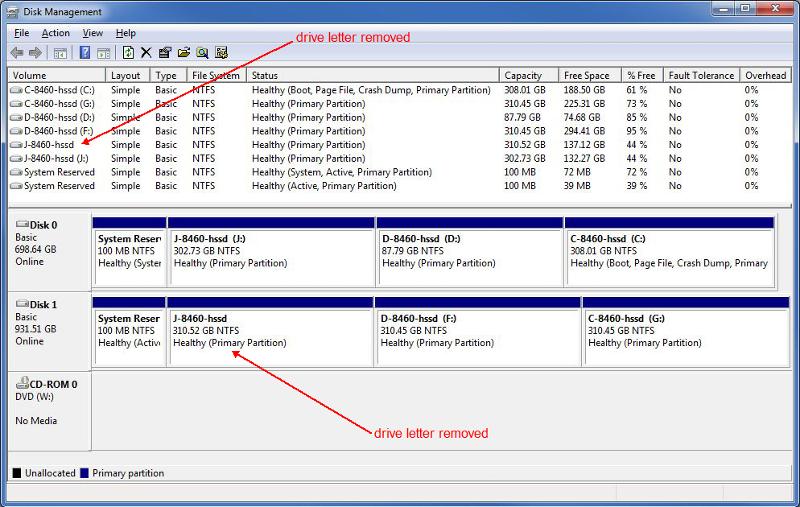
Once again, right-click on the partition (in either the top view or bottom view); only the Add button will be active:
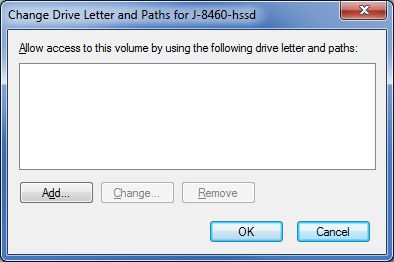
Click the Add button and you'll see this:
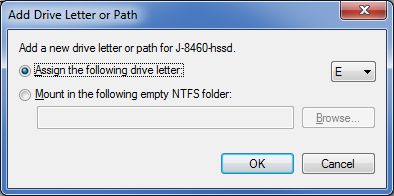
The Assign the following drive letter radio button will be enabled by default. You may now click the drop-down arrow next to the default drive letter shown (E in this case) and it will give you a choice of any available drive letter:
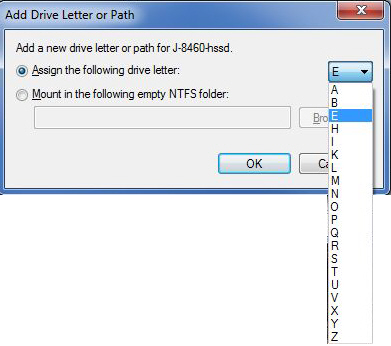
During the review/publication process, the always helpful EE Page Editors (in this case, lherrou and mark_wills) made suggestions for improvements to this article. One of those suggestions was a reminder about a big drive-letter villain – flash memory card readers. The problem is that a drive letter is typically assigned for every type of slot (CF, MemoryStick, MMC, SD, etc.) – even if no media is inserted! These card readers may be present in multiple places, such as monitors and all-in-one/multi-function devices. For example, I have a large LCD monitor with a built-in card reader that assigns four drive letters. Here's what Disk Management shows in the Graphical View:
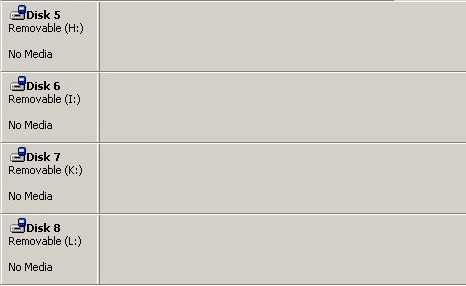
This card reader in my monitor is eating up four drive letters – H, I, K and L. In this case, the List View does not show the drives. So to remove the drive letter, you must right-click on the disk icon in the Graphical View, as shown for Disk 5, Removable (H:) below:
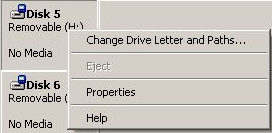
Selecting Change Drive Letter and Paths... allows you to remove the drive letter, as discussed earlier in the article. After doing that for the four disks in the card reader, I recovered drive letters H, I, K and L:

Of course, you may wish to remove just some of the drive letters, not all. For example, you may frequently use the card reader for SD cards, so having a drive letter for that is convenient, but you may not even own any CF cards, so removing that drive letter makes sense.
One final point. It is possible to remove the drive letter, yet still be able to access the drive in your file manager. To achieve this, let's go back to the Add Drive Letter or Path dialog but, this time, enable the Mount in the following empty NTFS folder radio button:
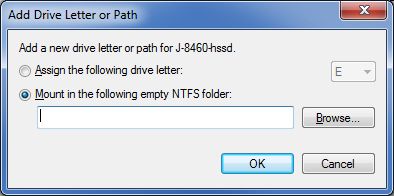
You should have first created an empty folder on some other NTFS drive (this technique works only on NTFS-formatted drives) for every partition that you wish to be able to access in your file manager. For example, I created folders called zC-clone-home-dock, zD-clone-home-dock, and zJ-clone-home-dock in the root of my D drive (I put the letter z in front so they sort at the bottom of the D drive folders). These are empty folders that will be used to mount the partitions that previously had the E, F and G letters assigned (and are the clones of my C, D and J drives). With an (empty) folder created, click the Browse button in the Add Drive Letter or Path dialog and navigate to it. Here's what mine looks like for the cloned C drive:
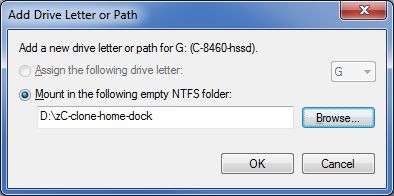
I repeated this for the cloned D and J drives, and now I have links to those drives which may be used to access them, as shown in this screenshot of Windows/File Explorer:
 Clicking on those links takes you into the drive in the same way as a drive letter!
Clicking on those links takes you into the drive in the same way as a drive letter!
Too bad that meeting in Bellevue didn't come up with an approach better than the 26-letter English alphabet, but I hope this article helps some EE members who are running out of drive letters.
If you find this article to be helpful, please click the thumbs-up icon below. This lets me know what is valuable for EE members and provides direction for future articles. Thanks very much! Regards, Joe
Have a question about something in this article? You can receive help directly from the article author. Sign up for a free trial to get started.


Comments (0)